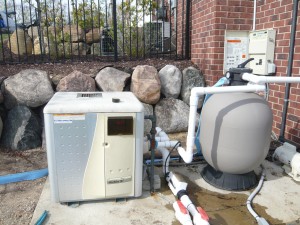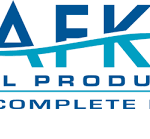How much salt do I need to add?
You only need to add salt to your pool or spa if your chlorinator control box indicates your levels are low or, obviously, you have completely (or significantly) drained your pool.
The salt level for a safe, chlorinated pool is about 2,500 to 4,000 PPM (parts per million). Most people can’t taste salt until the PPM is around 5,000. So for most people, it’s not even noticeable.
Here is how to figure out how much salt you would need after just filling it with fresh water.
If you don’t already know, estimate how many gallons your pool holds.
The formula (using feet) is:
Average Depth x Length x Width x 7.5 = Gallons
The average depth = (depth at shallow end + depth at deep end) divided by 2
Example:
The pool is 50’ long and 20’ wide. The shallow end is 3’ and the deep end is 9’.
Average depth = (3’ + 9’) / 2 = 6’
6’ x 50’ x 20’ x 7.5 = 45,000 gallons
If this is a new pool, you will need 50 lbs salt for every 2,000 gallons to get about 4,000 ppm, a good starting point. So for this example, you would need 1,125 lbs of salt
For existing pools, the previous usage of chlorine bleach or tablets will have already created a level of salt in the water. Have the water tested and then add the appropriate amount to establish 4,000 ppm.
Example:
The measurement for this same pool is 3,000 ppm.
So you need to add 1,000 ppm or ¼ of the example above = about 280 lbs
Once your salt level is established, there is no need to add salt unless the pool is drained or loses a significant amount of water. The most common ways you lose salt is through leaks, rainwater overflow, filter backwash, fun-time splashing, and what leaves on everyone’s swimsuit. Evaporation does not lose salt, it just increases the concentration. Add water to reduce the salt concentration back to 4000 ppm. Most chlorine generator units have low salt indicators and the digital type even give you the proper amount of salt needed to return to 4000 ppm.
How do I add the salt?
Pour it in. Agitation, sweeping, or brushing will help the salt dissolve faster. It will happen even faster if you turn on the pump, open the bottom drain, and add the salt over the drain. Running the pump for about 24 hours will dissolve it evenly throughout the pool. Granular salt will dissolve 60 – 70% before even hitting bottom. The remaining salt can simply be brushed into the drain. Other forms of salt, take longer to dissolve but the same actions will make apply.
What happens if I add too much?
You will have salty tasting water, but there is no harm done to your chlorine generating system. Some people like more salt because it is closer to their natural salinity level. It’s more comfortable for them.
If it is over 6000 ppm, you may damage metallic equipment, such as stainless steel handrails, ladders, filters, light rings, and copper heat exchangers. To reduce the salt level, drain some pool water and replace with fresh water. (Be careful where you drain the water, the salt will harm some plants.)
About Salt Systems
Salt systems are a huge trend in pools. The chlorine generators use ordinary salt and break it apart into sodium and chlorine. The chlorine cleans your pool and clears the water; then, when the chlorine has done it’s job, it hooks back up with the sodium and turns back into salt. The salt is recycled continuously, day after day, reducing maintenance requirements even more. A salt system is the easiest, most effective and convenient way to keep your pool clean. Chlorine generators provide the same sanitation performance as manual chlorine addition without the drawbacks–you never have to handle chlorine. You don’t need to buy and store chlorine compounds and you’ll never have to deal with the smell, stinging eyes and bleached bathing suits.
What is a Zinc Anode? Do I need one on a Salt Water Pool?
Yes, you ABSOLUTELY MUST have a zinc anode on a salt water pool!
A zinc anode is an important part of your chlorine generating system. It is protects the metal components of your swimming pool from corrosion. The zinc anode will be the first thing to corrode, saving the other parts of your pool from corrosion. We are happy to quote a salt system if you might want to convert your pool to a salt/chlorine generating pool. If you have a salt pool already – double check to make sure you have a zinc anode. They are often overlooked, and are a critical part of your system!












